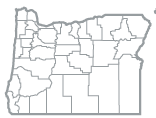 10 reasons why you shouldn’t panic.
10 reasons why you shouldn’t panic.
And 9 reasons why you should
 DON’T PANIC
DON’T PANIC
HERE ARE 10 REASONS TO BELIEVE THAT THE ECONOMIC STORM WON’T SINK OREGON — BUT KEEP THOSE LIFE JACKETS HANDY.
BY BEN JACKLET / RESEARCH BY JASON SHUFFLER
PANIC
OK, so it hasn’t been a banner year for the Oregon economy.
In fact it has been awful, with unemployment spiking, bankruptcies rising and home values falling, not to mention the loss of the Hynix factory in Eugene and the Freightliner plant in Portland. We could go on but we won’t. 2008 was not a year worthy of review.
But that doesn’t mean it is time to panic. As dismal as the forecast appears, there are reasons for hope. Granted, each dish of optimism comes with a side order of gloom. But as longtime regional economist John Mitchell reminds us, “Every recession we’ve ever had has ended.”
Here are the keys to Oregon’s turnaround, our top 10 reasons not to panic. On the flip side, we also offer nine reasons why you might want to consider panicking after all. The careful reader will notice that the positive trends for Oregon are reverse images of the negative trends. This duplicity is not to be avoided. These are volatile, even schizophrenic, times.
Those attempting to predict the future are strongly advised to hedge all bets, consider all angles, and above all else, not to panic.
| ONE:HOUSING | ||||
 DON’T PANIC. IT COULD HAVE BEEN WORSE We are not California. We are not Nevada, Florida or Arizona. Oregon’s real estate market is in poor shape, but it could be worse. Yes, home prices in Oregon shot up during the boom years, but not with the same abandon that buoyed and sank so many other markets. The state’s land use laws deterred some of the sprawling speculative building. It took home values much longer to begin falling. In addition, homebuyers here were less reliant on dodgy subprime loans. As a result, Oregon is below the national average for foreclosures and price drops. Home prices have fallen about 8% in Portland over the past year, as compared to more than 30% in Las Vegas and Phoenix. It will take less pain to get the market moving again.
Not that it will be pain-free. Home sales are down more than 30% statewide and will not recover until prices drop further. That’s grim news for would-be sellers, but good news for intelligent buyers. There are advantages to coming to the party late. Builders stop building before the market gets completely swamped with inventory. Brokers stop selling dodgy mortgage loans because they can no longer insure them. Bailout programs to stem the bleeding take hold before it is too late. The correction is under way: Prices are falling, inventory is thinning (somewhat) and builders are hanging tight for signs of a rebound. It could be a long wait; for some it has already been too long. But once prices come down, the housing market should regain its balance by the end of 2009. | PANIC! IT’S GETTING WORSE There are two basic theories concerning Oregon’s exposure to the housing meltdown. The first holds that Oregon is less vulnerable because run-ups were less extreme and irresponsible loans were the exception rather than the norm. The second holds that the bubble inflated later here and burst even later, meaning the market has further to drop to reach bottom and begin recovering. The numbers seem to back the more pessimistic theory. Median prices in the state’s largest housing market, metro Portland, reached their peak latest of the 20 cities tracked by the Case-Shiller Home Price Index. Their recent drop mirrors precisely the fall-offs that other cities began experiencing in 2005 and 2006. If the trend holds, prices will continue falling here while they rebound elsewhere, and Oregon will be late to the recovery once again.
The key statistic is months of inventory: the number of homes on the market divided by how many are selling each month. Portland has more months of inventory (10) on the market than Las Vegas (8.8). Bend has 15 months’ worth. The Portland condo market has a whopping five years’ worth. That’s more than Miami. A recent report from the national forecasting firm Global Insight rates Bend as the second- most overvalued housing market in the nation. Portland (No. 7), Eugene (No. 11) and Medford (No. 16) also made the top 20 among 330 metropolitan areas. That’s because wages and wealth did not keep pace with the run-up in home prices in Oregon. Now that the easy money loans have been stripped away, homes are unaffordable. Until prices fall significantly, stagnation will rule. | |||
| TWO: GREEN | ||||
| DON’T PANIC. THE BOOM IN ALTERNATIVE ENERGY IS COMING It’s a rare stump speech in Oregon where sustainability isn’t the central theme, and get this — it isn’t all fluff. Major global players are moving into Oregon. Jobs are being created. With the announcement from Sanyo that it will build an $80 million solar factory in Salem, Oregon now has seven solar manufacturing facilities, including the largest in North America, SolarWorld’s new $440 million plant in Hillsboro. Other solar giants are considering Oregon because the state offers available workers with the right skills, inexpensive electricity and the most aggressive business energy tax credits in the nation.
Then there are the compelling if secretive plans of SpectraWatt, Intel’s solar spin-off. The last time Intel’s engineers honed in on improving efficiency, they transformed computers from clunkers into miracle workers. Who’s to say similar advances in solar cells won’t be next? The wind-power boom isn’t all hot air, either. Oregon ranks seventh in the nation with 964 megawatts installed and another 298 megawatts under construction. The Danish windmill maker Vestas employs hundreds at its U.S. headquarters in Portland, and the Spanish renewable powerhouse Iberdrola has established a significant foothold in Oregon following its purchase of Pacific Power Marketing. Combine those foreign investments with home-grown innovations in green building, geothermal, smart electricity grids, woody biomass, wave energy and biodiesel, and you get a diversified sector that is adding jobs. That trend is bound to accelerate as policymakers move to modernize the economy by slapping a price tag on greenhouse gas emissions. It could build into a gold rush on multiple fronts, especially if President-elect Barack Obama follows through on his plan to invest $150 billion over 10 years to create 5 million new “green collar” jobs. If sustainability is the future, Oregon is well positioned. |  PANIC! PANIC!THE BOOM IS A BUBBLE Your first clue lies in investigating some of the players who have invested most optimistically in clean tech, such as Lehman Brothers and American Insurance Group. They sure knew how to hype markets and leverage money, but where are they now? Oregon’s rush to lead the way to a sustainable, low-pollution future powered by solar photovoltaics, hydrogen fuel cells and biodiesel is noble. It also may prove a costly dud. The state has paid out millions of dollars in subsidies to solar, which is not even close to competing with other sources of energy. That inconvenient truth has become abundantly clear as oil prices have plunged back toward earth, dragging with them the stock prices of formerly high-flying solar companies. Sound familiar? Cheap oil also undermined the last great push to advance solar power, during the Carter era.
It takes subsidies for alternative energy to compete. Also, the revolution would need to be financed by billions if not trillions of dollars from Wall Street and venture capitalists. That means big-time leverage, which is why Lehman and AIG were so deep into clean tech. Now that the truth is out about those once-mighty magicians, these do not seem like good times to be reliant on creative financing. Another unknown is the carbon market. Putting a price tag on emissions helps the green initiatives that Oregon specializes in add up to profits. But political interest in lowering greenhouse gas emissions tends to wane during times of crisis. The terrorist attacks of 2001 and the Iraq War both knocked climate change right off the priority list. A global financial meltdown may do the same. | |||
| THREE: EXPORTS | ||||
| DON’T PANIC. EXPORTS WILL PULL US THROUGH For most of 2008, the weak dollar was a good thing for Oregon’s trade economy, converting Silicon Forest chips, Pendleton wheat and Willamette Valley grass seed into cold, hard currency. Oregon exports for the first half of 2008 totaled $9.9 billion, up 24% over 2007. Leading the growth was King Ag, up 82%. Shipments of computer and electronics to China shot up 61%. Agricultural commodities shipped to Japan skyrocketed 124%.
Then something unexpected happened. The dollar grew stronger. More accurately, other currencies plunged against the dollar as the financial mess spread. Wheat farmers watched with disgust as a resurgent dollar brought down wheat prices just after a weak dollar had inflated fuel expenses during the harvest. Stability in global currency markets is crucial for Oregon because we rank eighth among states in exports per capita. Odds are, at some point the dollar will drop back down, and exports will bounce back. That will bring prosperity. Oregon’s most important trading partners are not the Hungaries and Icelands of the world, but Asian powerhouses such as China and Japan and rising powers such as Malaysia and the Philippines. It goes without saying that the most significant future market will be in China, which is loaded with cash reserves for a future in which cash will be king. Please send some our way, if you would be so kind. |  PANIC! EXPORTS ARE IN TROUBLE It is crazy to watch the dollar grow stronger as the U.S. economy melts down. But that’s what’s happening and it’s bad news for Oregon exporters. If the trend holds they will need to sell more of their products to earn the same amount of money, and these will be tough times to increase sales, even to countries with relatively strong economies.
The problem is, many farmers, food processors and manufacturers have invested ambitiously based on the assumption that the dollar would remain weak or deteriorate further, bringing higher export prices. Covering those investments could prove challenging. If the dollar remains strong for too long, or grows stronger still, trade jobs will be lost and farmers risk losing much of what they have gained during the booming food years of 2007 and 2008. Big global businesses will suffer along with rural communities. The Pacific Rim nations that trade heavily with Oregon started 2008 economically strong but their strength has withered as the crisis has spread. Stock markets in Japan, South Korea, Hong Kong and even China have fallen dramatically over the past year. That trend does not bode well for the future of Oregon exports. | |||
| FOUR: BANKS | ||||
| DON’T PANIC. OUR BANKS ARE STRONG Oregon’s financial sector has never been a powerhouse. This is a positive. Now is the time to be far from Wall Street in as many ways as possible. Small, independent banks headquartered in Oregon and large banks with major holdings here have performed relatively well amid the meltdown. For some, stocks have fallen and loan loss provisions are rising. But they are not bleeding money and going under. The exception is Washington Mutual, based in Seattle with a sizable presence in Oregon, the biggest bank failure in history. Oregon’s top holder of deposits, U.S. Bancorp, formerly headquartered in Portland, bucked the national trend by holding steady from September 2007 to September 2008. Its profits are down 22%, but a drop-off in profits beats a fresh pile of losses.
Oregon’s top mortgage lender, Wells Fargo, earned $8 billion in profits through the first three quarters of 2008. Wells Fargo didn’t follow the sucker’s money into liar loans, and now it is gobbling up major assets at discount prices. Bank of America, second in Oregon market share, also has grown, snapping up Countrywide and Merrill Lynch on the cheap. Digesting those two entities will take time. Still, better to eat than to be eaten. Umpqua Bank, the largest institution headquartered in Oregon, survived a tough stretch to boost earnings, deposits and new mortgages. Local banks such as Eugene-based Pacific Continental Bank and credit unions such as OnPoint picked up new members by marketing themselves as sensible alternatives to the lunacy of Wall Street. What this means going into 2009 and beyond is that the financial foundation upon which Oregon’s businesses rely is relatively strong — the operative word being relatively. |  PANIC! NO ONE’S BANKS ARE IMMUNE To think Oregon is somehow immune to the toxicity spreading throughout the global economy would be parochial and naïve. No financial institution is immune, and Oregon’s exposure is not to be taken lightly. Washington Mutual was the third-largest bank in Oregon by deposits and one of the state’s top mortgage lenders when it failed. Those problems have not vanished just because J.P. Morgan Chase bought up WaMu’s remains. U.S. Bancorp has exposure to Lehman Brothers and nonperforming construction loans in California. KeyBank, another major lender in Oregon, swung to a loss in the third quarter. The Dalles-headquartered Columbia River Bancorp is scrambling to cover looming mortgage and construction losses and recently saw its CEO and CFO resign.
The pressure is building for many banks because Oregon’s real estate market will probably falter further before it rebounds. Behind every half-finished condo project in Portland, every unsold new home in Bend and every vacant would-be resort lot in the countryside there are lenders watching with fingers crossed. The pressure will intensify as the weakness spreads into the commercial real estate market in 2009. Even Oregon’s super-local credit unions have issues after years of making auto loans to consumers with a variety of credit histories. Repos are on the rise, and the SUVs aren’t exactly flying off the lots. No one is immune. | |||
| FIVE: EMPLOYERS | ||||
| DON’T PANIC. OUR MAJOR EMPLOYERS ARE SOLID New York lost Lehman Brothers and Bear Stearns. Washington lost Washington Mutual. Michigan may end up losing one, two or all three of its Big Three automakers. Oregon has Nike, king of sports, and Intel, masters of the computer chip. Start with Nike, the largest Oregon-headquartered company. Yes, analysts are predicting slower retail sales. But Nike’s sales are way up in China and other emerging markets, and holding ground domestically. The company has powered through retail slumps before. As has Intel. The Santa Clara, Cal.-based blue chip chipmaker is Oregon’s largest private employer, and if markets were ruled by results it would be continuing its ascent. Intel made $2 billion in profits last quarter, holds $3.8 billion in cash reserves and is delving into solar power while tightening its lock on the market for computer chips. In a time when predicting anything is risky, it seems reasonable to predict that the market for Intel chips made in Oregon is a solid bet for the long haul.
Oregon’s newest addition to the Fortune 500 list, Precision Castparts, is a lesser-known entity. Its stock has fluctuated wildly amid an ambitious buying spree that netted nine companies over the past five years. Whether Precision can make all its acquisitions work together remains to be seen, but it is clearly growing and expanding in ways that will benefit the economy. None of Oregon’s public companies has performed particularly well on the stock market this year. But just because people are panicking doesn’t mean they should be. Once the fear recedes, stocks will tick upward, along with the economy. |  PANIC! PANIC!OUR MAJOR EMPLOYERS ARE DOWNSIZING The timing was terrible. Just months after the loss of 1,400 jobs at the Hynix plant in Eugene, Daimler/Freightliner announced it will halt production in Portland and cut at least 900 jobs. Factor in the coming cutbacks to all the support businesses that relied on these two giants and the job losses will number in the thousands. The same gloom applies to the timber industry. Jobs continue to vanish and Pope & Talbot, an Oregon pillar for 150 years, has gone bankrupt.
Hewlett-Packard, on the other hand, can hardly be said to be struggling, with over $6 billion in profits through the first three quarters of 2008. That isn’t stopping H-P from cutting back in Corvallis and Vancouver, Wash., shedding hundreds of high-paying jobs. Even recent winners are feeling tremors. Schnitzer Steel rode commodity prices to historic highs over the summer, only to see its stock dive-bomb by 70% over three months of market chaos. Oregon’s largest privately held employer, window and door giant JELD-WEN, has cut jobs in southern Oregon, as has Lithia Motors. The state’s second-largest privately held company, Hoffman Construction, is dealing with multi-million-dollar liens and a projected drop-off in commercial building. The list of Oregon homebuilders facing insolvency is growing. As for RV manufacturers and auto dealers, don’t ask. The virus is spreading. | |||
| SIX: STATE | ||||
| DON’T PANIC. THE STATE HAS WISED UP Oregon entered the previous recession in 2001-2003 with zero in reserves and was forced to make major cuts to public education. This time state government reserves are approaching $700 million if you combine the rainy day fund with the education stability fund. Portland also holds about $700 million in reserves. This is encouraging for several reasons. Cash reserves boost bond ratings, which will come in handy once the bond market improves. City and state governments will be able to borrow for public works projects that create jobs and improve infrastructure.
More immediately, rainy day reserves might provide a means to avoid crippling budget cuts. Two of the triggers that allow legislators to tap into these funds — falling general revenues and two or more quarters of consecutive job loss — have already fired. That sets the stage for a 60% majority vote to use up to two-thirds of the money. Revenues are falling but at least Oregon does not rely on a sales tax. A fall-off in consumer spending won’t devastate our budget as immediately as it has in Washington State, which recently took an 11% hit. Yes, it will rain, and it will keep raining for some time, but that’s what rainy day funds are for. Besides, real Oregonians can take a little rain; after a while we don’t even notice it. More importantly, the state plans to revive the economy through public works, selling bonds to rebuild infrastructure and create thousands of new jobs. |  PANIC! PANIC!THE STATE WILL PAY FOR ITS DENIAL As recently as June, state economists predicted that the economic downturn would be short-lived in Oregon due to the comparative strength of our housing markets, relatively low foreclosure rate and strong exports. Their forecast called for flat job growth through 2008 followed by moderate growth for 2009.
Three months later they deleted the section about Oregon’s relative strength, noted that building permits and housing starts had fallen “more than expected” and dropped their revenue forecast by $119 million. Then in mid-November they revised their numbers even further downward and made ample use of the word recession while tallying up the mounting job losses. The bleak November forecast forced the governor to order immediate reductions to fight off a $142 million deficit. By over-estimating the strength of Oregon’s position as the storm approached, the state has set itself up for deep budget cuts that could weaken the economy further. | |||
| SEVEN: PORK | ||||
 DON’T PANIC. TIMBER PAYMENTS WILL BOOST RURAL OREGON Sure, they’re pork, but they’re our pork. A bridge to nowhere is better than no bridge at all for Oregon’s hurting rural economies.
And yes, taxpayers in most of the affected counties contribute far less than the average in property taxes. But remember why: They are surrounded by huge swaths of government land that bring no tax revenues. Besides, let’s face it, the transformation out of timber and into the future isn’t penciling out for rural Oregon, as evidenced by the near bankruptcies of Josephine and Curry counties. Real incomes are falling and frustration is peaking. Getting $800 million over four years for libraries, sheriffs and roads will help, big time. Provided they are treated as a vital investment in rural Oregon — rather than an entitlement — county timber payments should soften the blow of the hardships to come, and help with the ongoing struggle to diversify ex-timber-town economies. | PANIC! TIMBER PAYMENTS HAVE NOT TRANSFORMED RURAL ECONOMIES The question isn’t whether rural counties are dependent on timber payments. They are. Or whether timber payments will help in the short term. They will. The question is, are the payments going to help rural Oregon over the long haul to move beyond dependency?
When Oregon’s rural counties began receiving payments from the federal government in 2000, it was intended to be a short-term loan to replace lost revenues from timber harvest on public lands, not a perpetual allowance to enable counties to provide services without paying for them. Property tax rates in the counties most reliant on the payments, Josephine and Curry, are about one-third of the state average. The problem with pork is that it can become an unhealthy addiction. Pork is different from an economic development incentive in that it doesn’t encourage the diversification of the private sector. Libraries and sheriffs are good and necessary elements of civic life, but where will the public jobs go when the federal money runs out? Raising local property taxes to pay for roads and libraries would require voter approval; good luck passing that measure in hard times. More likely rural counties will have little choice but to treat timber payments as life support rather than investments in the future. | |||
| EIGHT: TIMBER | ||||
| DON’T PANIC. WE HAVE TREES IN THE BANK Oregon has 16 million acres of forests. The days of chopping them down at top speed to maximize profits are history. But at some point those trees will regain their value.
Granted the lumber market is in the tank. Mills are closing and building permits and housing starts are rarities. But the trees are still there, storing carbon and growing larger. Over time, population growth will force the housing market to revive. This is already happening in housing markets that fell hard early, such as Las Vegas and Miami. California will be next. Builders will resume building, and they will need wood. Log prices will bounce back as demand awakens. And creative thinkers within the timber industry will figure out ways to supplement harvest income with carbon offset revenues and woody biomass energy projects. This is not to say that the mill jobs will return. But money is bound to flow back into timber, probably in different ways than it has in the past. Those who get out in front of the changes and invest strategically will benefit. |  PANIC! THE TIMBER INDUSTRY IS IN DEEP TROUBLE Oregon may emerge from each new recession stronger and more diversified, but the timber industry does not. The cyclical beatings of each drop-off within the housing market have taken their toll on attempts to modernize and upgrade, and the industry has been losing clout and jobs for decades.
That trend is unlikely to reverse. Log prices are down 36% from their June 2004 levels. California’s real estate market is far from recovery and flooded with homes that are not selling. The reason timberland owners are so interested in carbon offsets and woody debris energy production and anything else that can squeeze money out of the forest is simple: The outlook for the timber industry is not good. | |||
| NINE: NEWCOMERS |  | |||
| DON’T PANIC. PEOPLE AND BUSINESSES KEEP MOVING HERE Oregon has mountains, rivers and beaches, vast swaths of parkland, a low crime rate, a diversified economy and really tasty coffee, beer and wine. It is no wonder that people continue to migrate here — even during hard times. That wasn’t always the case. In the early 1980s, when the timber industry was disintegrating and unemployment was soaring, more people moved out of Oregon than into it for five years in a row. The opposite happened during the most recent recession. People kept pouring into Portland, Eugene and Bend despite a lack of jobs. That trend is here to stay.
The state’s population grows by about 1.6% each year, and 65% of that growth consists of newcomers rather than newborns. Many of the newcomers are young, well educated and from fairly affluent families, a great demographic to prop up sales for Powell’s Books, Oregon farmer’s markets, the McMenamins Empire, Willamette Vineyards, Mount Hood Meadows, New Seasons Market, Stumptown Coffee and Deschutes Brewery. They bring creativity and talent, a fair number of trust funds and the occasional brilliant business idea. They also contribute to the continuing diversification of Oregon’s economy. | PANIC! THE NEWCOMERS WILL DRIVE UP UNEMPLOYMENT RATES History teaches that unemployment continues to rise even after recessions pass. The lingering pain of the jobless recovery is bound to last longer when newcomers migrate to chase quality of life rather than quality jobs. This means that anyone winging it to Portland or Bend on a whim risks a rude awakening when it comes time to pay the bills.
From October 2007 to October 2008, Oregon lost 11,100 construction jobs, 5,300 leisure and hospitality jobs, 3,200 retail trade jobs, 2,600 administrative and support services jobs, 2,100 real estate jobs, 2,000 financial sector jobs, 1,200 architectural and engineering jobs and 900 logging jobs. With a shrinking job market and a growing population, it looks as if Oregon’s unemployment rate will continue to hover above the national rate. Wages and salaries, already well below the national average here, will likely stagnate. According to the state’s economic forecast, real personal income is expected to go backward through 2010. On the positive side, this should mean that the businesses that stand up to the slowdown and expand will have ample choices for hiring. |
| TEN: DON’T PANIC PANICKING DOESN’T HELP |
| Seriously. Don’t panic. We’re not even going to give you the option of panicking on this one. The rebound lies ahead, somewhere. We will get there eventually. |
Have an opinion? E-mail [email protected]

